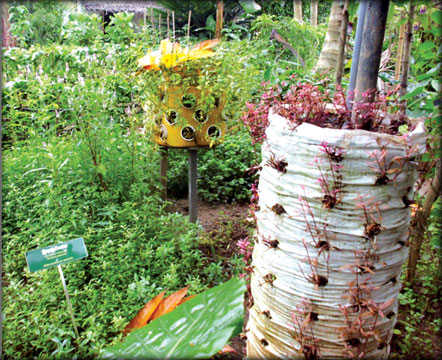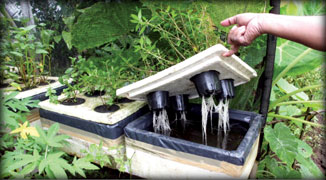|
Gannoruwa Agro-Technology Park:
A blend of edutainment and adventure
by Ganga Ratnayake
Have you ever been to a park where a walk from one side to another
provides you glimpses of all the crops and herbs found across Sri Lanka?
Take another walk and you would come across a humble household of a
farmer from as far as a century ago.
 |
|
Model home garden |
Another walk will see you suddenly emerge amidst alluring butterflies
from the tiniest to giant-sized, flaunting stunning hues and patterns.
The list goes on and the excitement goes up when you are touring the
Gannoruwa Agro-Technology Park in Kandy - a one of a kind place where
learning becomes an irresistible adventure.
The Gannoruwa Agro-Technology Park is situated along the Gannoruwa
Road, not too far from the world renowned Royal Botanic Gardens in
Peradeniya. Its land area - covering two square kilometres - is halved
by the Gannoruwa Road with each half comprising many interesting
sections. Operated under the Department of Agriculture, the park has
around 15 facilitators, to provide guidance and support to the visitors,
apart from instructing and demonstrating scores of processes whenever
needed.
On November 15, a little before 11.00 am, we arrived at the Gannoruwa
Agro-Technology Park. We entered through an arched canopy adorned in
vines and came upon a charming clay hut with a thatched roof, which
turned out to be the ticket booth. Our tour began right after I met Dr.
Rohan Wijekoon, Director of the Audio Visual Centre at Gannoruwa Park
and the very person who conceptualised the park and made it into a
reality in 2004.
Edible Landscaping
With Dr. Wijekoon who designed the park to guide us, we began the
tour from the nearby vegetable garden which was classified as Edible
Landscaping. There were numerous vegetable plants grown in striking
patterns and tucked in between were cactus plants of all shapes and
sizes. On the right stood a row of dragon fruit trees. The plants
received plenty of sunlight as they were naturally aligned to face the
East and the path of the sun.
After leaving the Edible Landscaping section, we crossed the
Gannoruwa Road and entered the other side of the park. The first place
we explored was the Model Home Garden with an arched entrance made of
Granadilla (tantin) vines. It was rich in colours and contained all
kinds of vegetables including vines, root and leafy vegetables. Some
were grown in discarded barrels, bins and gunny sacks, demonstrating how
one can make the most of one’s little space. The plants were also
labelled in three languages along with their botanical names. In
addition to plants growing on soil, there were some grown in a liquid
base using a technique called hydroponics.
 |
|
Dead insects on a wall
display at the insect zoo |
Our next stop was the Agricultural Museum which was set up in a
two-storey building surrounded by traditional granaries built for
storing paddy, finger millet (kurakkan) and straw. The museum had many
exhibits including a fine diorama of a scenic village backdrop with all
components of a traditional paddy field. Many farming tools were on
display, ranging from the ancient to the recent. There were also
hand-made traps used to chase away birds and other pests.
The museum also housed some interesting artefacts which made us feel
as if we were exploring an ancient household in a farming community.
There were ancient umbrellas made of palmyrah leaves, big square
slippers that looked robust and glossy as well as scores of kitchenware
and containers of all sizes. There was even a showcase with four tiers
displaying a wide variety of paddy seeds, both edible and wild.
Despite the drizzle and the gloomy weather, we left the museum and
started climbing up and down the sloping terrains. In a short time we
came upon the next site which was the Mushroom Garden. In a small room
housing many shelves facing one another, there were mushrooms growing
out of neatly stocked bags. Dr. Wijekoon explained that this room
demonstrates the precise dimensions, temperature and other aspects
required for growing mushrooms for commercial purposes.
As we climbed further, we came upon the mushroom museum which was
packed with pickled mushrooms of all colours and sizes. These
well-preserved mushrooms in jars included the more common oyster
mushrooms, the favoured button mushrooms and a wide variety of mushrooms
found in the wild including poisonous mushrooms, all labelled and
classified. Adjoining this museum was a small lecture hall where
visitors are given demonstrations and instructions on growing mushrooms,
upon request.
On the way to the next stop, we passed another neat room displaying
smaller jars on shelves. Dr. Wijekoon explained that this was the Tissue
Culture Division, specifically built to educate and demonstrate the
farmers on culturing tissues in the convenience of their homes. In fact,
disseminating knowledge and agro-technology to farmers and growers of
commercial crops in all parts of the country take a leading role at the
Agro-Technology Park.
Plant diseases
I wondered how hard it must be to take care of hundreds and thousands
of plants in such a vast area. Indeed, like humans falling sick, plants
too tend to fall sick. So, to enlighten the public about plant diseases,
the Plant Pathology Unit was set up, which was our next stop. After
walking under a shady vine canopy, we entered a room displaying numerous
plants, infected with various illnesses. The visitors can not only
observe the living examples, but also learn what causes these diseases
and how to prevent them in future.
 |
|
Hydroponics method |
Time to time, we had to watch our footing as the rainy weather had
made the terrain muddy and slippery. However, a walk through a kingdom
of plants sprawling as far as the eyes can see was a wonderful
experience, filling our lungs with fresh air and our minds with
inspiration. The feeling turned into excitement as we stepped into the
Insect Zoo teeming with creepy-crawlies of all sizes, colours and
shapes.
Apart from live bugs dwelling on their favourite plants in glass
boxes, there were dead specimens adorning the walls. Some boxes had
spiders, crabs and scorpions while others had bugs of interesting
shapes. There were dead specimens of insects on a wall display including
different species of grasshoppers, dragonflies, walking sticks and
praying mantises. Another wall display had dozens of butterflies with
wingspans ranging from one centimetre to one foot, and colours varying
from pale greens to vibrant blues. There was also a small butterfly
garden where butterflies played hide-and-seek inside a micro jungle.
Here one could identify pests and learn various methods to control them.
Even though an hour had passed, our tour was still far from over. We
set off in another direction, passing through lush crops and scenic
landscapes, hoping to explore more in this agro-park brimming with
biodiversity.
|



